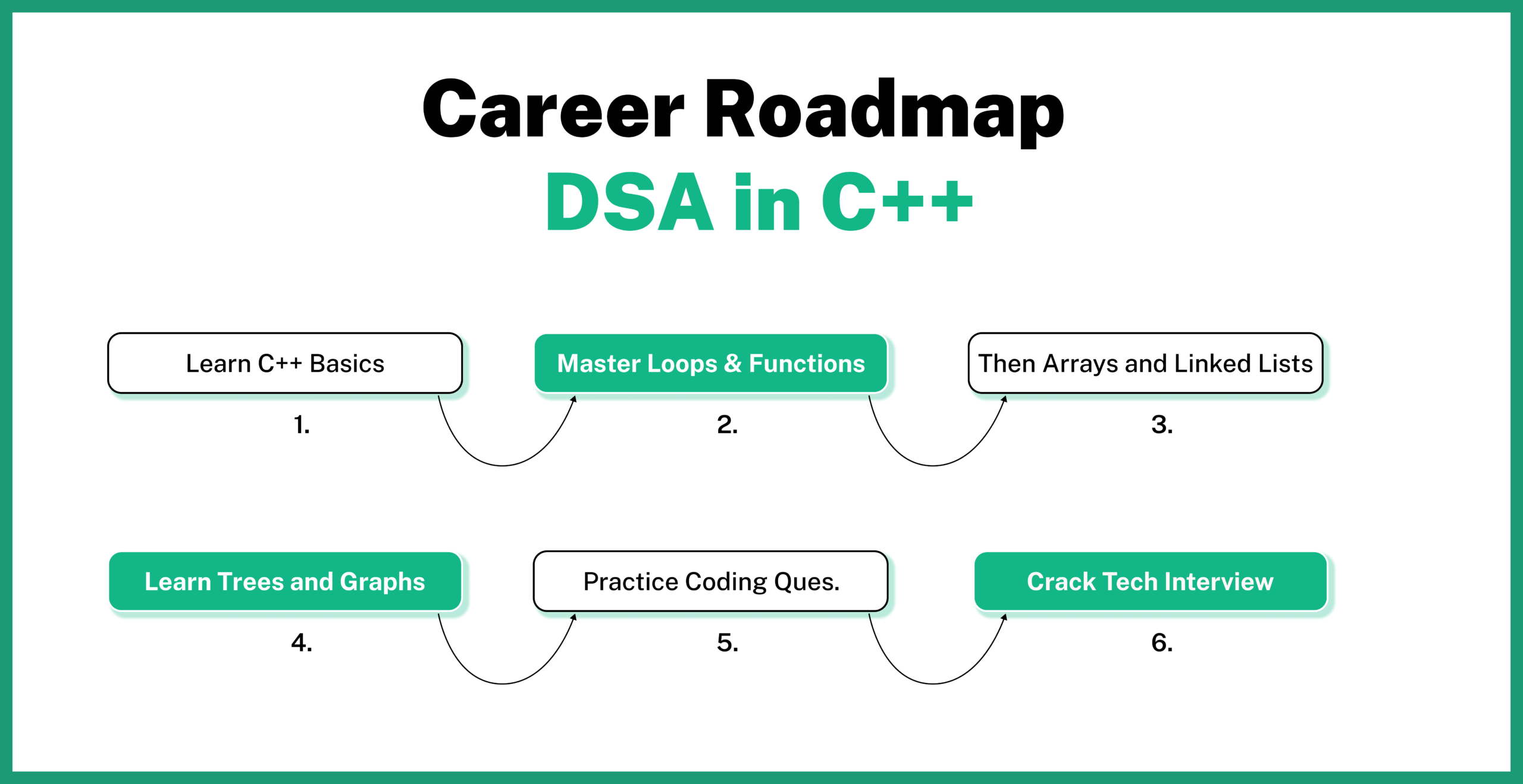Data Structures and Algorithms in C++
Learn Data Structures and Algorithms in C++ : From Basics to Advance
Data Structures and Algorithms in C++ – If you are a beginner or a college student learning programming, you must have heard a lot about Data Structures and Algorithms, or simply DSA. Especially if you are learning C++, DSA becomes even more important as it lays the foundation for coding interviews, competitive programming, and building efficient software.
In this blog, we will understand what DSA in C++ really means, why it’s important, and how you can get started with it in a simple and clear way.

Learn Data Structures and Algorithms in C++ : From Basics to Advance
Data Structures and Algorithms in C++ – If you are a beginner or a college student learning programming, you must have heard a lot about Data Structures and Algorithms, or simply DSA. Especially if you are learning C++, DSA becomes even more important as it lays the foundation for coding interviews, competitive programming, and building efficient software.
In this blog, we will understand what DSA in C++ really means, why it’s important, and how you can get started with it in a simple and clear way.
What is DSA in C++?
DSA stands for Data Structures and Algorithms. It is a combination of two major concepts:
- Data Structures: These are ways of organizing and storing data in a computer so that we can perform operations like searching, sorting, inserting, and deleting efficiently.
- Algorithms: These are step-by-step methods or procedures used to solve a specific problem using data structures.
Why Data Structures and Algorithms in C++ is Important ?
Learning Data Structures and Algorithms (DSA) in C++ is a smart choice for students and aspiring developers. C++ is a powerful and high-performance language, and using it to learn DSA comes with several key advantages:
- Better Understanding of Memory
C++ gives you more control over memory through features like pointers and manual memory allocation. This helps you understand how data is stored and managed, which is essential when learning structures like arrays, linked lists, stacks, and trees. - Fast Execution – Great for Competitive Programming
C++ is one of the fastest programming languages. Its speed helps you write programs that run efficiently, which is especially useful in coding competitions and interviews where time limits matter. - Close to Real Implementations
With C++ being object-oriented, you can build data structures as classes. This makes your learning more practical and helps you understand how things work behind the scenes in real-world applications. - STL – A Powerful Toolkit
C++ includes the Standard Template Library (STL), which provides ready-made data structures like vectors, maps, sets, and algorithms. While it’s better to implement your own structures while learning, STL can save a lot of time once you’re comfortable with the basics. - Builds Strong Programming Foundations
Learning DSA in C++ strengthens your programming skills. You’ll practice writing clean code, handling input/output, using loops, functions, and more. These core skills make it easier to pick up other languages in the future.
Prerequisites Before Learning DSA in C++
- Set up a C++ compiler and IDE like Code::Blocks or VS Code.
- Understand variables, data types, and basic input/output using cin and cout.
- Be familiar with operators (+, -, *, &&, ||) and conditional statements (if, else, switch).
- Know how to use loops (for, while, do-while) and define functions.
- Have a basic idea of user-defined types (struct, class) and optionally, the Standard Template Library (STL).
Get PrepInsta Prime & get Access to all 200+ courses offered by PrepInsta in One Subscription
What is DSA in C++?
DSA stands for Data Structures and Algorithms. It is a combination of two major concepts:
- Data Structures: These are ways of organizing and storing data in a computer so that we can perform operations like searching, sorting, inserting, and deleting efficiently.
- Algorithms: These are step-by-step methods or procedures used to solve a specific problem using data structures.
Why Data Structures and Algorithms in C++ is Important ?
Learning Data Structures and Algorithms (DSA) in C++ is a smart choice for students and aspiring developers. C++ is a powerful and high-performance language, and using it to learn DSA comes with several key advantages:
- Better Understanding of Memory
C++ gives you more control over memory through features like pointers and manual memory allocation. This helps you understand how data is stored and managed, which is essential when learning structures like arrays, linked lists, stacks, and trees. - Fast Execution – Great for Competitive Programming
C++ is one of the fastest programming languages. Its speed helps you write programs that run efficiently, which is especially useful in coding competitions and interviews where time limits matter. - Close to Real Implementations
With C++ being object-oriented, you can build data structures as classes. This makes your learning more practical and helps you understand how things work behind the scenes in real-world applications. - STL – A Powerful Toolkit
C++ includes the Standard Template Library (STL), which provides ready-made data structures like vectors, maps, sets, and algorithms. While it’s better to implement your own structures while learning, STL can save a lot of time once you’re comfortable with the basics. - Builds Strong Programming Foundations
Learning DSA in C++ strengthens your programming skills. You’ll practice writing clean code, handling input/output, using loops, functions, and more. These core skills make it easier to pick up other languages in the future.
Prerequisites Before Learning DSA in C++
- Set up a C++ compiler and IDE like Code::Blocks or VS Code.
- Understand variables, data types, and basic input/output using cin and cout.
- Be familiar with operators (+, -, *, &&, ||) and conditional statements (if, else, switch).
- Know how to use loops (for, while, do-while) and define functions.
- Have a basic idea of user-defined types (struct, class) and optionally, the Standard Template Library (STL).
Searching in C++
Searching in Data Structures and Algorithms in C++ is the process of finding a specific element within a data structure. The two main techniques are Linear Search and Binary Search.


Sorting
Sorting in C++ is the process of arranging elements in a specific order, typically ascending or descending. It helps improve the efficiency of searching and data processing.
- Common sorting techniques include Bubble Sort, Selection Sort, Merge Sort, and Quick Sort, each with different time complexities and use cases.
Linked List
A Linked List in C++ is a dynamic data structure where elements, called nodes, are connected using pointers.
- Each node contains data and a pointer to the next node, allowing efficient insertion and deletion without shifting elements.
- It’s commonly used when the size of the data is unknown or frequently changes.
- Linked List in C++
- Singly Linked List in C++
- Linked List Insertion in C++
- Insertion at Beginning in Singly Linked List in C++
- Insert a Node at specific Position in a Singly Linked List in C++
- Insertion at End in Singly Linked List in C++
- Deletion in Singly Linked List in C++
- Deletion from beginning in singly linked list in C++
- Delete nth node in Linked List in C++
- Print Frequency of Elements in an Array (Naive Approach)
- Deletion from end in singly linked list in C++
- Reverse a linked list without changing links between nodes in C++
- C++ program to reverse a linked list by changing links between nodes
- C++ program to print reverse a linked list without actually reversing
- C++ program to search an element in the linked list
- C++ program for insertion in a Sorted Linked List
- C++ program to delete alternate nodes of a Linked List
- C++ program to find middle of the linked list
- C++ program to reverse a linked list in groups of given size
- C++ program to find kth node from end of the linked list
- C++ program to append the last n nodes of a linked list to the beginning of the list
- C++ program to check whether linked list is palindrome or not
- C++ program to fold a linked list
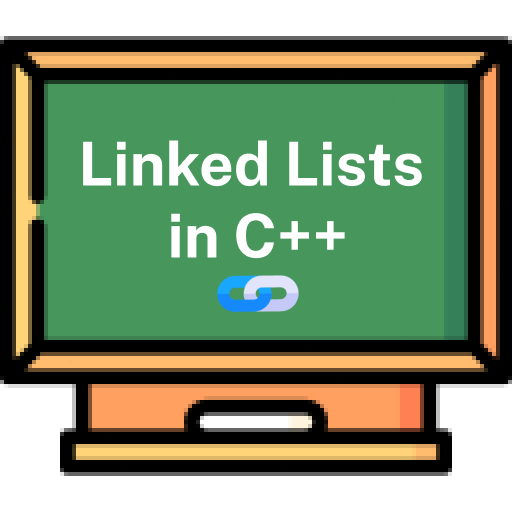
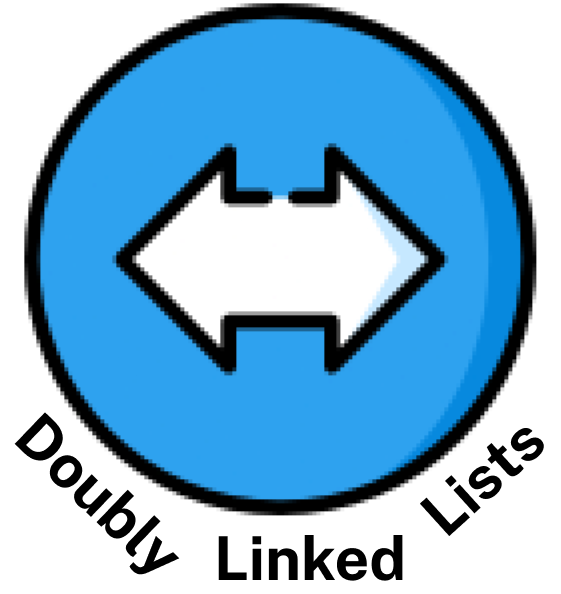
Doubly Linked List
A Doubly Linked List in C++ is a type of linked list where each node contains data, a pointer to the next node, and a pointer to the previous node.
- This bidirectional linking allows traversal in both forward and backward directions, making insertion and deletion more flexible compared to a singly linked list.
- Doubly Linked List in C++
- Insertion in Doubly Linked List in C++
- Insertion at Beginning in Doubly Linked list in C++
- Insertion at End in Doubly Linked list in C++
- Insertion in between the nodes in doubly linked list in C++
- Deletion in Doubly Linked List in C++
- Deletion from Beginning in Doubly Linked List in C++
- Deletion of target node in doubly linked list in C++
- Deletion from End in Doubly Linked List in C++
Circular Linked List
A Circular Linked List is a variation of the linked list where the last node points back to the first node, forming a circle.
- It can be singly or doubly linked and allows continuous traversal from any node, making it useful in applications like round-robin scheduling or circular buffers.
- Circular Linked List in C++
- Insertion in circular linked list in C++
- Insertion at the beginning in Circular Linked List in C++
- Insertion at end in Circular Linked List in C++
- Insertion at specific position in Circular Linked List in C++
- Deletion in Circular Linked List in C++
- Deletion from beginning in circular linked list in C++
- Deletion from specific position in circular linked list in C++
- Deletion from end in circular linked list in C++
- C++ program to split a circular linked list into two halves
- C++ program to count nodes in circular linked list
- C++ program to insert in a sorted circular linked list
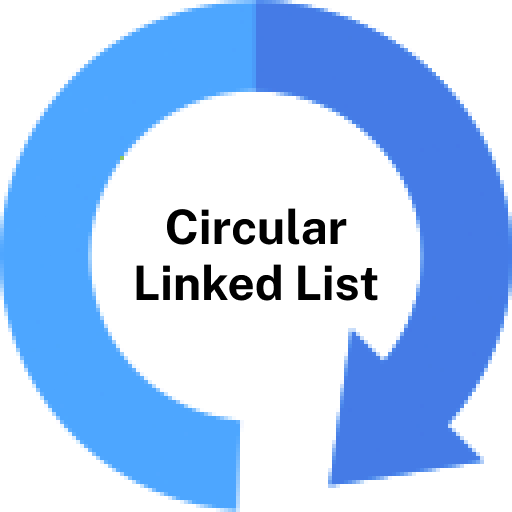

Stack and Queues
Stack and Queue are linear data structures used to store and manage data.
- A Stack follows the LIFO (Last In, First Out) principle, where the last inserted element is accessed first, while a Queue follows FIFO (First In, First Out), where the first inserted element is removed first.
- Both are essential in algorithm design and memory management.
Stack for DSA in C++ 🔽
Queue for DSA in C++ 🔽
Circular Queue in C++ 🔽
Priority Queue in C++ 🔽
Trees
A Binary Tree is a hierarchical data structure in which each node has at most two children, referred to as the left and right child.
- It is widely used for representing structured data and forms the basis for more advanced trees like Binary Search Trees (BST) and Heaps.
Binary Trees
- Tree Traversals: Inorder Postorder Preorder In C++
- Inorder Tree Traversal in Binary Tree In C++
- Preorder Tree Traversal in Binary Tree In C++
- Postorder Tree Traversal In Binary Tree In C++
- Inorder Tree Traversal Without Recursion In C++
- Preorder Traversal Without Recursion in C++
- Postorder Tree Traversal Without Recursion in C++
Binary Search Trees
- Binary Search Tree Program
- Search a Node in a Binary search tree in C++
- Insertion In A Binary Search Tree In C++
- Deletion In Binary Search Tree In C++
- Tree Traversals: Breadth-First Search (BFS)
- Tree Traversals: Depth First Search (DFS)
- Insertion In B-Tree C++
- Deletion In B-Tree C++
- AVL Trees
- Insertion in AVL Tree In C++
- Deletion In AVL Tree In C++
- Insertion in a Binary Tree (Level Order)
- Searching In A Binary Tree In C++
- Searching In A Binary Search Tree In C++
- Level Order Traversal Of A Tree In C++
- Construct Tree From Given Inorder and Preorder traversals in C++
- Construct Tree from given Postorder and Inorder Traversals in C++
- Construct Tree From Given Postorder And Preorder Traversal In C++
- Find Size Of Binary Tree In C++
- Height Of A Binary Tree in C++
- Find Maximum Element in Binary Tree in C++
- Check whether 2 Binary trees are identical or not
- Spiral order Traversal of Binary Tree code in C++
- Level Order Traversal LIne by Line code in C++
- Hand shaking lemma and some Impotant Tree Properties
- Foldable Binary Tree in C++
- Check whether two trees are symmetrical or not
- Check for Children-Sum property in Binary Tree
- Sum of all nodes in Binary Tree code in C++
- Lowest Common Ancestor(LCA) in Binary Tree in C++

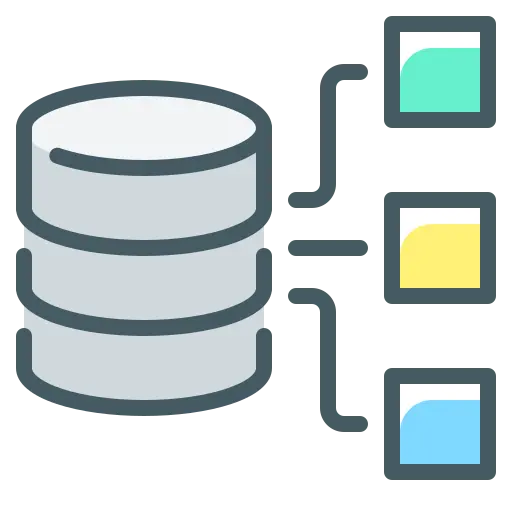
Arrays
An Array in C++ is a fixed-size, contiguous collection of elements of the same data type, stored in memory.
- It allows fast access using indices but has a static size, meaning it cannot grow or shrink during runtime.
- Arrays are commonly used for storing and manipulating lists of data efficiently.
- Introduction to Arrays
- Introduction to 2-D Arrays in C++
- Sorting of array in C++
- Array Rotation in C++
- Reverse of an Array in C++
- Find Pairs in Array with Given Sum in C++
- Sort Array in Waveform in C++
- Majority Element in an Array in C++
- Boyer–Moore Majority Vote Algorithm
- K-pairs with smallest sum in 2 arrays in C++
- Largest Sum Contigous SubArray in C++
- Maximum Average subarray of k length in C++
- Size of subarray with max sum code in C++
- Sub-array with given sum in C++
- Triplet that sum to a given value in C++
- Segregate 0’s and 1 ‘s in array
- Segregate 0’s and 1’s and 2’s in array in C++
- Program for Sorting of elements by frequency in C++
- Find Pythagorean Triplets from array
- Merging two sorted arrays in C++
- Minimum number of Merge Operations to make an Array Palindrome
- Find Zeros to be Flipped so that number of Consecutive 1’s is maximized
Explore DSA in Your Favorite Language
You can also learn and practice DSA in other popular languages like C, Java, and Python, just pick the one you’re most comfortable with 🙂
🔵 DSA in C
- Start your DSA journey in C and build a strong foundation step by step.
👉 [Start Learning in C]
🟢 DSA in Java
- Master DSA in Java and get interview-ready with real coding practice.
👉 [Start Learning in Java]
🔴 DSA in Python
- Learn DSA in Python with simple syntax and powerful logic building.
👉 [Start Learning in Python]
Searching in C++
Searching in C++ is the process of finding a specific element within a data structure. The two main techniques are Linear Search and Binary Search.


Sorting
Sorting in C++ is the process of arranging elements in a specific order, typically ascending or descending. It helps improve the efficiency of searching and data processing.
- Common sorting techniques include Bubble Sort, Selection Sort, Merge Sort, and Quick Sort, each with different time complexities and use cases.
Linked List
A Linked List in C++ is a dynamic data structure where elements, called nodes, are connected using pointers.
- Each node contains data and a pointer to the next node, allowing efficient insertion and deletion without shifting elements.
- It’s commonly used when the size of the data is unknown or frequently changes.
- Linked List in C++
- Singly Linked List in C++
- Linked List Insertion in C++
- Insertion at Beginning in Singly Linked List in C++
- Insert a Node at specific Position in a Singly Linked List in C++
- Insertion at End in Singly Linked List in C++
- Deletion in Singly Linked List in C++
- Deletion from beginning in singly linked list in C++
- Delete nth node in Linked List in C++
- Print Frequency of Elements in an Array (Naive Approach)
- Deletion from end in singly linked list in C++
- Reverse a linked list without changing links between nodes in C++
- C++ program to reverse a linked list by changing links between nodes
- C++ program to print reverse a linked list without actually reversing
- C++ program to search an element in the linked list
- C++ program for insertion in a Sorted Linked List
- C++ program to delete alternate nodes of a Linked List
- C++ program to find middle of the linked list
- C++ program to reverse a linked list in groups of given size
- C++ program to find kth node from end of the linked list
- C++ program to append the last n nodes of a linked list to the beginning of the list
- C++ program to check whether linked list is palindrome or not
- C++ program to fold a linked list


Doubly Linked List
A Doubly Linked List in C++ is a type of linked list where each node contains data, a pointer to the next node, and a pointer to the previous node.
- This bidirectional linking allows traversal in both forward and backward directions, making insertion and deletion more flexible compared to a singly linked list.
- Doubly Linked List in C++
- Insertion in Doubly Linked List in C++
- Insertion at Beginning in Doubly Linked list in C++
- Insertion at End in Doubly Linked list in C++
- Insertion in between the nodes in doubly linked list in C++
- Deletion in Doubly Linked List in C++
- Deletion from Beginning in Doubly Linked List in C++
- Deletion of target node in doubly linked list in C++
- Deletion from End in Doubly Linked List in C++
Circular Linked List
A Circular Linked List is a variation of the linked list where the last node points back to the first node, forming a circle.
- It can be singly or doubly linked and allows continuous traversal from any node, making it useful in applications like round-robin scheduling or circular buffers.
- Circular Linked List in C++
- Insertion in circular linked list in C++
- Insertion at the beginning in Circular Linked List in C++
- Insertion at end in Circular Linked List in C++
- Insertion at specific position in Circular Linked List in C++
- Deletion in Circular Linked List in C++
- Deletion from beginning in circular linked list in C++
- Deletion from specific position in circular linked list in C++
- Deletion from end in circular linked list in C++
- C++ program to split a circular linked list into two halves
- C++ program to count nodes in circular linked list
- C++ program to insert in a sorted circular linked list


Stack and Queues
Stack and Queue are linear data structures used to store and manage data.
- A Stack follows the LIFO (Last In, First Out) principle, where the last inserted element is accessed first, while a Queue follows FIFO (First In, First Out), where the first inserted element is removed first.
- Both are essential in algorithm design and memory management.
Stack for DSA in C++ 🔽
Queue for DSA in C++ 🔽
Circular Queue in C++ 🔽
Priority Queue in C++ 🔽
Trees
A Binary Tree is a hierarchical data structure in which each node has at most two children, referred to as the left and right child.
- It is widely used for representing structured data and forms the basis for more advanced trees like Binary Search Trees (BST) and Heaps.
Binary Trees
- Tree Traversals: Inorder Postorder Preorder In C++
- Inorder Tree Traversal in Binary Tree In C++
- Preorder Tree Traversal in Binary Tree In C++
- Postorder Tree Traversal In Binary Tree In C++
- Inorder Tree Traversal Without Recursion In C++
- Preorder Traversal Without Recursion in C++
- Postorder Tree Traversal Without Recursion in C++
Binary Search Trees
- Binary Search Tree Program
- Search a Node in a Binary search tree in C++
- Insertion In A Binary Search Tree In C++
- Deletion In Binary Search Tree In C++
- Tree Traversals: Breadth-First Search (BFS)
- Tree Traversals: Depth First Search (DFS)
- Insertion In B-Tree C++
- Deletion In B-Tree C++
- AVL Trees
- Insertion in AVL Tree In C++
- Deletion In AVL Tree In C++
- Insertion in a Binary Tree (Level Order)
- Searching In A Binary Tree In C++
- Searching In A Binary Search Tree In C++
- Level Order Traversal Of A Tree In C++
- Construct Tree From Given Inorder and Preorder traversals in C++
- Construct Tree from given Postorder and Inorder Traversals in C++
- Construct Tree From Given Postorder And Preorder Traversal In C++
- Find Size Of Binary Tree In C++
- Height Of A Binary Tree in C++
- Find Maximum Element in Binary Tree in C++
- Check whether 2 Binary trees are identical or not
- Spiral order Traversal of Binary Tree code in C++
- Level Order Traversal LIne by Line code in C++
- Hand shaking lemma and some Impotant Tree Properties
- Foldable Binary Tree in C++
- Check whether two trees are symmetrical or not
- Check for Children-Sum property in Binary Tree
- Sum of all nodes in Binary Tree code in C++
- Lowest Common Ancestor(LCA) in Binary Tree in C++


Arrays
An Array in C++ is a fixed-size, contiguous collection of elements of the same data type, stored in memory.
- It allows fast access using indices but has a static size, meaning it cannot grow or shrink during runtime.
- Arrays are commonly used for storing and manipulating lists of data efficiently.
- Introduction to Arrays
- Introduction to 2-D Arrays in C++
- Sorting of array in C++
- Array Rotation in C++
- Reverse of an Array in C++
- Find Pairs in Array with Given Sum in C++
- Sort Array in Waveform in C++
- Majority Element in an Array in C++
- Boyer–Moore Majority Vote Algorithm
- K-pairs with smallest sum in 2 arrays in C++
- Largest Sum Contigous SubArray in C++
- Maximum Average subarray of k length in C++
- Size of subarray with max sum code in C++
- Sub-array with given sum in C++
- Triplet that sum to a given value in C++
- Segregate 0’s and 1 ‘s in array
- Segregate 0’s and 1’s and 2’s in array in C++
- Program for Sorting of elements by frequency in C++
- Find Pythagorean Triplets from array
- Merging two sorted arrays in C++
- Minimum number of Merge Operations to make an Array Palindrome
- Find Zeros to be Flipped so that number of Consecutive 1’s is maximized
Explore DSA in Your Favorite Language
You can also learn and practice DSA in other popular languages like C, Java, and Python, just pick the one you’re most comfortable with 🙂
🔵 DSA in C
- Start your DSA journey in C and build a strong foundation step by step.
👉 [Start Learning in C]
🟢 DSA in Java
- Master DSA in Java and get interview-ready with real coding practice.
👉 [Start Learning in Java]
🔴 DSA in Python
- Learn DSA in Python with simple syntax and powerful logic building.
👉 [Start Learning in Python]
Get over 200+ course One Subscription
Courses like AI/ML, Cloud Computing, Ethical Hacking, C, C++, Java, Python, DSA (All Languages), Competitive Coding (All Languages), TCS, Infosys, Wipro, Amazon, DBMS, SQL and others

